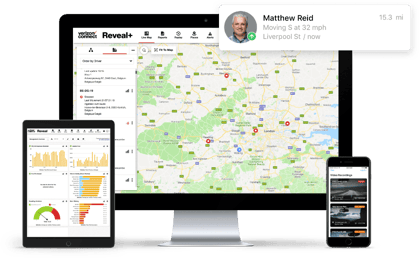For fleet managers, increasing fleet productivity and decreasing costs is a top priority. Investing in fleet tracking technology to help manage your fleet is one of the most effective ways to realise these goals.
According to the Fleet Technology Trends Report Europe 2023, conducted for Verizon Connect by ABI Research, a majority of fleet managers and executives across industries indicate that GPS tracking has had a beneficial impact on their fleet operations.
- 76% consider fleet tracking ‘very’ or ‘extremely’ beneficial
- 59% across all industries saw improved productivity post-adoption
- 33% also saw a positive ROI within 6 months after implementing a fleet management solution
It’s clear that fleet tracking can help improve many facets of operations that contribute to vehicle fleet management. Let’s take a closer look at what fleets and fleet managers can achieve with the right telematics technology.
Improve vehicle fleet management: 4 insights from fleet managers
Contributing to fleet route optimisation. By continually monitoring every vehicle’s location, a vehicle fleet management system provides multiple data points for dynamic route optimisation, including vehicle stops, mileage, individual driving patterns and other important management data.
Effective route planning is critical to a fleet’s success. With the right route optimisation software, fleets can:
- View a near real-time comprehensive map of all current vehicle locations and their status
- Use the closest-vehicle function to specify an address and locate the closest vehicle
- Route a specific vehicle to the next job
- Review vehicle location history online
- Track weekly distance travelled
- Monitor mileage trends with various easy-to-run reports
Download our free eBook about the bottom-line benefits of optimising your workforce to learn more about the 9 benefits that fleets can experience using vehicle fleet management software.
Finding additional ways to reduce fuel costs. Vehicle fleet management software lets you stay on top of operational aspects that impact efficient fuel consumption, such as:
- Speeding: Maintaining proper speeds can significantly reduce fuel usage. See speed events per driver and set up alerts that are triggered any time a driver breaches a specific speed threshold.
- Idling: Monitor unnecessary, wasteful idling and receive alerts any time a vehicle has been idling for too long.
- Fuel monitoring: Integrate fuel cards with software and run reports that show total fuel spend per vehicle and the location of each fill-up. Track miles per litre, pinpoint causes of high fuel consumption, reduce fuel slippage (e.g., stolen fuel) and enforce fuel-saving habits.
- Helping to prioritise security and safety: Keeping tabs on how every driver operates every vehicle and knowing each vehicle’s condition before it hits the road can be a daunting task. Vehicle tracking can help managers understand where issues exist and where improvements can be made towards achieving safety and compliance standards.
Here are a few examples of how telematics can help prioritise safety and security:
- Vehicle theft and unauthorised use: Use geofences to place virtual boundaries around designated geographical areas to track fleet vehicles as they move in and out of those areas. Tracking can also help authorities in the event a vehicle is stolen.
- Routine maintenance: Know when vehicles are due for maintenance. Along with helping to keep vehicles safe, this helps keep vehicles on the road longer and operating costs low.
- Visual evidence: Use integrated video to get a holistic view of driving conditions at any point in time. View driver footage alongside road-facing footage to help mitigate false claims, promote driver safety and document accident circumstances.
- Speeding: Monitor vehicle speed and location, compare vehicle speeds against posted speed limits when planning vehicle routes, and track speeding incidents by driver and vehicle.
- Hard braking and acceleration: This behaviour is risky and can damage vehicles, making them unsafe to operate. Get a clear picture of engine and vehicle diagnostics by identifying when and where these events occur.
- Reviewing and refining vehicle and asset utilisation. Knowing which vehicles are unused or underused is just as important as knowing where active vehicles are and what they’re doing. With the right fleet tracking solution, managers can receive detailed reporting metrics around miles travelled, days utilised, number of trips and more. This can help identify vehicles that may be underutilised, or not needed in the fleet at all.
Helpful features include:
- Route planning: By knowing the most efficient routes to take, drivers can get more done in less time.
- Asset management and utilisation: Asset-tracking hardware lets you easily monitor and track equipment – both powered and non-powered assets – to always know the location and usage.
- Vehicle usage data: Easily analyse annual vehicle utilisation by model and year to reveal whether older vehicles are used inefficiently and are candidates for elimination to reduce overall fleet size. Optimising fleet size helps you manage a leaner, more efficient fleet.
- Job history: Know where vehicles have been when they arrived and how long they stayed.
Fleet tracking technology can help improve your vehicle fleet management efforts, streamline operations, and gain a competitive edge.
Find out how our platform gives you the visibility you need to get more done.




